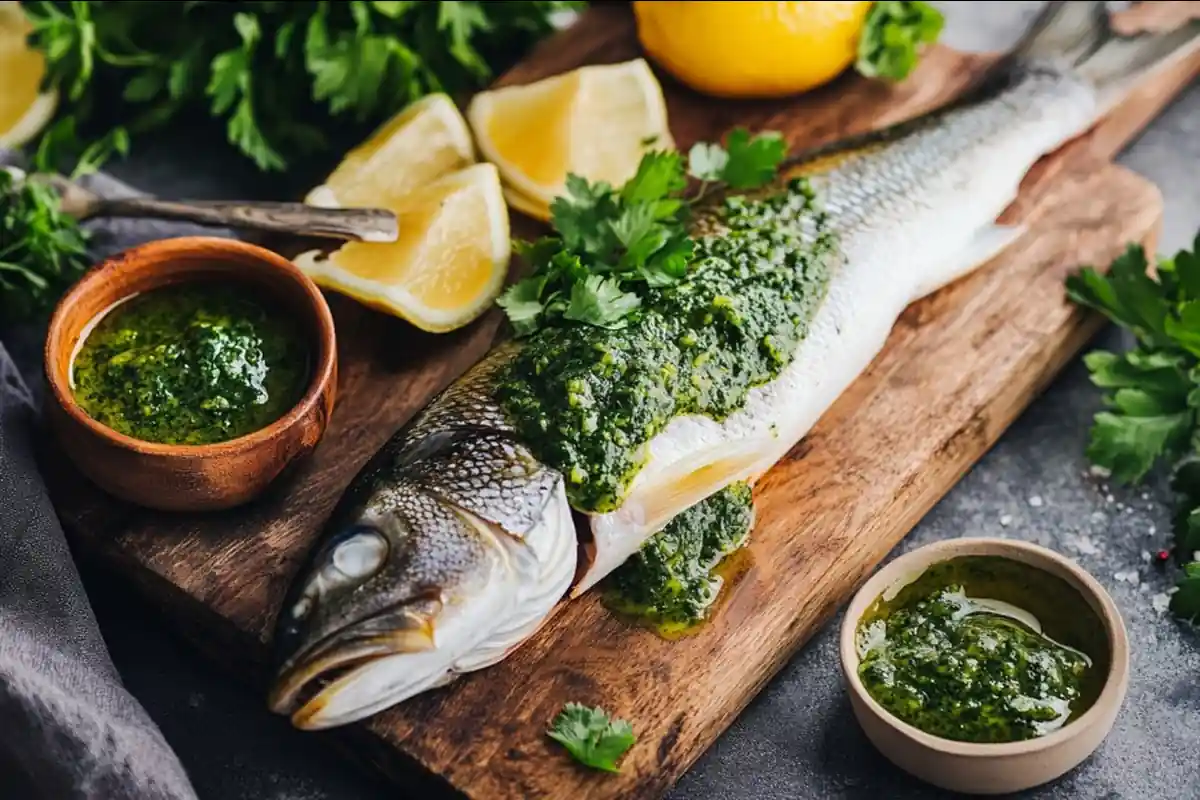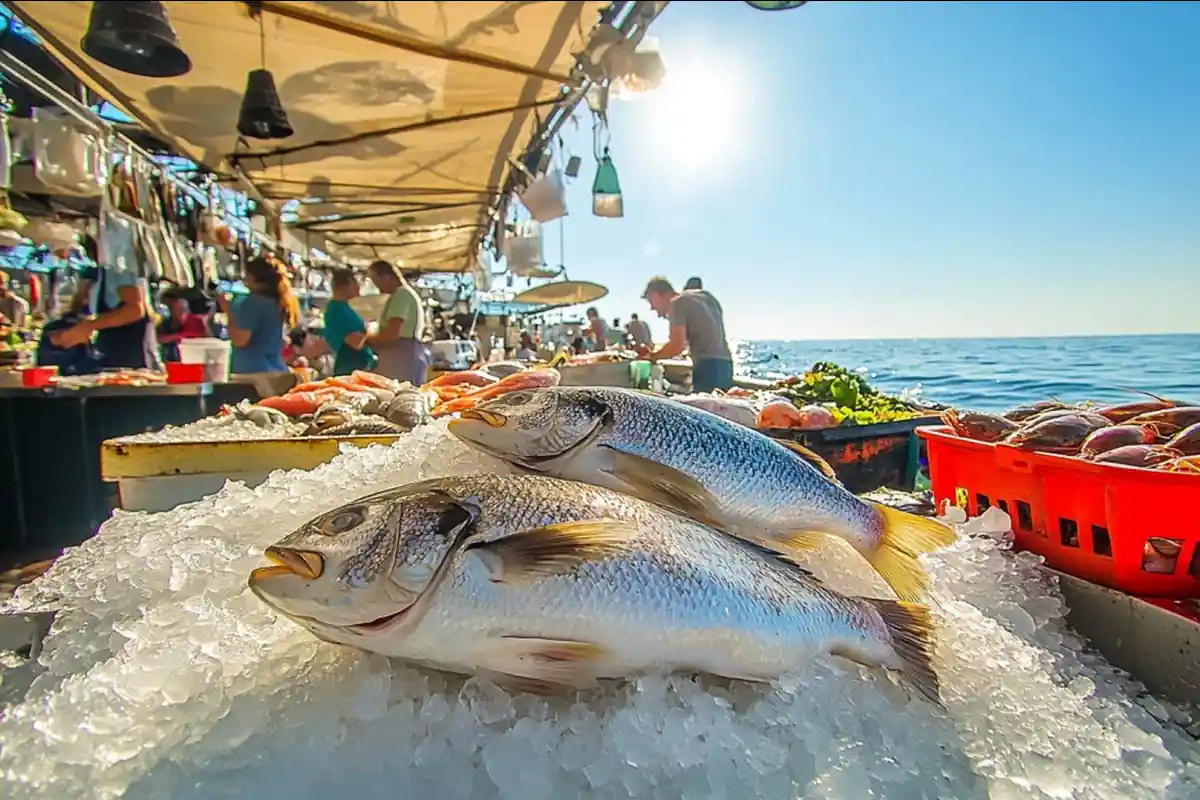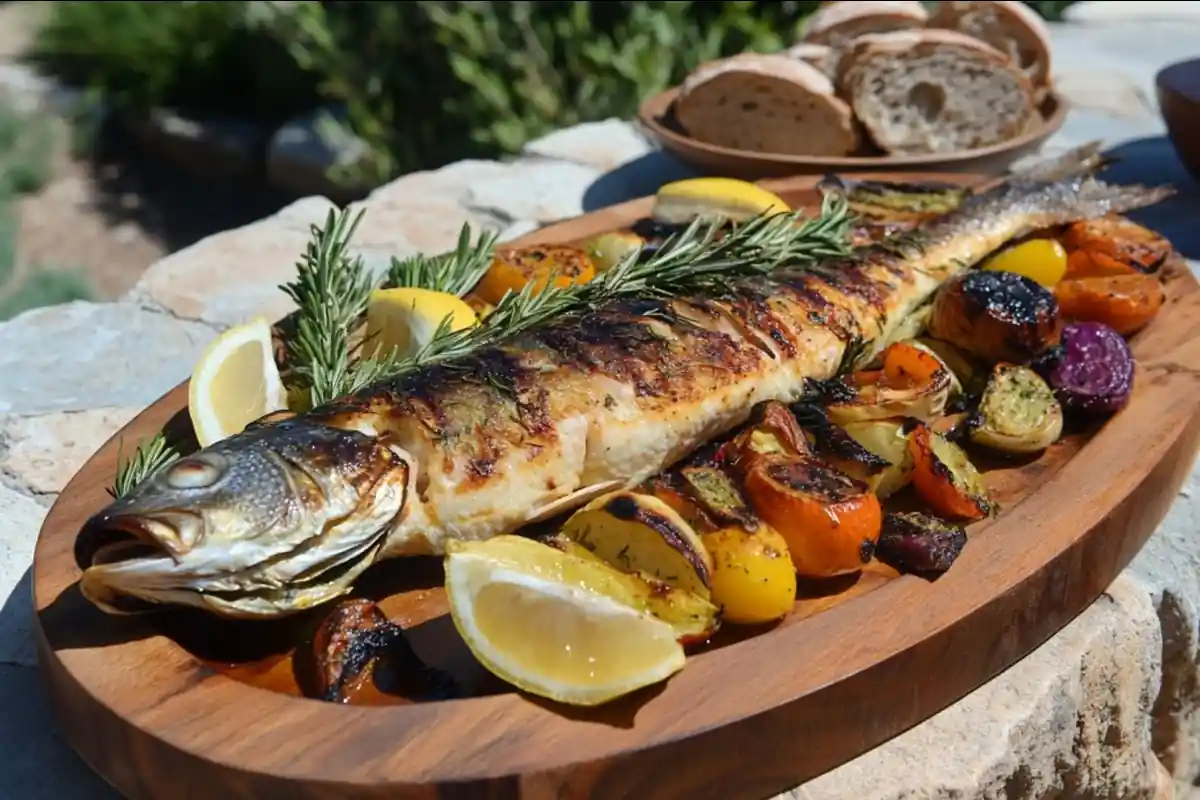1. What Kind of Fish is Branzino?
What kind of fish is branzino? Known as the European sea bass (Dicentrarchus labrax), branzino is a mild, white fish celebrated in Mediterranean cuisine for its delicate sweetness and tender texture. Native to the Mediterranean Sea and North Atlantic Ocean, branzino has become a culinary favorite on restaurant menus and in home kitchens worldwide.
This fish is a true Mediterranean staple, reflecting the region’s love for fresh, flavorful, and healthful ingredients. From Italy to Greece, it’s celebrated for its versatility and cultural significance. Whether you’ve heard it called branzini, bronzinino, or simply sea bass, its culinary charm is undeniable.
In this comprehensive guide, we’ll dive into its origins, nutritional value, sustainability, cooking methods, and more to showcase why branzino deserves a spot on your plate.
1.1 The Basics of Branzino
1.1.1 Scientific Classification and Common Names
To understand what kind of fish is branzino, it’s essential to know its scientific classification. Branzino belongs to the Moronidae family and is scientifically named Dicentrarchus labrax. While widely referred to as European sea bass, it is also known as branzini in Italian and bronzinino in some regions.
Interestingly, while Italians typically call it branzino, other Mediterranean regions have their unique names for the fish, reflecting its widespread culinary use. Despite its many names, the characteristics of this fish remain consistent: mild, flaky, and irresistibly delicious.
1.1.2 Origin and Natural Habitat
Branzino thrives in the coastal waters of the Mediterranean Sea and the North Atlantic Ocean, particularly near warm, rocky shores and estuaries. This fish has adapted to various environments, including lagoons and salt marshes, where its population is abundant.
Its preference for warmer climates and accessibility in Mediterranean waters made it a cornerstone of regional diets, influencing traditional recipes that have now gained global popularity.
1.1.3 Why It’s Loved in Mediterranean Cuisine
The mild flavor and tender texture of branzino make it an ideal canvas for the bright, fresh flavors synonymous with Mediterranean dishes. Paired with olive oil, lemon, garlic, and herbs like rosemary or thyme, it transforms into a delightful meal.
Moreover, branzino is prized for being versatile—it can be grilled whole, roasted in an oven, or filleted and pan-seared for various culinary styles.
2. Taste and Texture of Branzino
2.1 What Kind of Fish is Branzino Known For?
What kind of fish is branzino known for? Its mild, slightly sweet, and clean flavor profile makes branzino a versatile choice for countless recipes. This Mediterranean favorite shines in dishes where subtle seasoning can highlight its natural charm. Its light taste allows it to absorb seasonings and marinades beautifully, elevating its natural charm. This mildness is why it is often favored over stronger-tasting fish like mackerel or bluefish.
In terms of texture, branzino has a delicate yet firm flesh that flakes effortlessly once cooked. Its consistency is soft enough to melt in the mouth but holds its form well during preparation. The light and flaky nature of the fish make it suitable for both simple and intricate recipes.
2.2 How Branzino Compares to Other Mild White Fish
When asking what kind of fish is branzino, its standout feature is the balance of mild flavor and flaky texture that sets it apart from other white fish.Compared to tilapia, which can lean bland, branzino offers a subtly sweet and richer taste. Unlike cod, which has a firmer texture, branzino’s tender, flaky meat provides a more delicate eating experience.
Chilean sea bass, often compared with branzino, is more buttery and fatty, while branzino is lighter and less oily. For those looking for a healthy, light meal that doesn’t compromise on flavor, branzino is an ideal option.
3. Nutritional and Health Benefits of Branzino
3.1 Is Branzino a Healthy Fish to Eat?
When exploring what kind of fish is branzino, its nutritional profile is a key reason for its popularity. Branzino isn’t just delicious—it’s also packed with essential nutrients, making it a healthy and flavorful addition to any diet. Known for being a low-calorie, high-protein food, it fits seamlessly into a healthy diet. With its rich profile of essential nutrients, branzino promotes overall well-being and supports various aspects of health.
Here’s a nutritional breakdown for a 100-gram serving of branzino:
- Calories: 97
- Protein: 18g
- Fat: 2g (mostly unsaturated)
- Omega-3 Fatty Acids: ~0.8g
- Vitamins: High in Vitamin D and B12
- Minerals: Contains potassium, selenium, and phosphorus
This nutritional composition highlights why branzino is considered a light yet nutrient-dense seafood option.
3.2 Health Benefits of Eating Branzino
- Heart Health
Branzino is rich in omega-3 fatty acids, which have been shown to reduce inflammation, lower cholesterol, and improve heart health. Regular consumption can decrease the risk of cardiovascular diseases. - Brain Function
Omega-3s also play a critical role in maintaining brain health. They support cognitive function, improve memory, and may even reduce the risk of neurological conditions such as Alzheimer’s disease. - Skin and Hair Health
The high-quality protein and healthy fats in branzino contribute to glowing skin and stronger hair. Its Vitamin D content also supports skin health by aiding in the repair of damaged cells. - Low in Mercury
Compared to larger fish like tuna or swordfish, branzino is low in mercury, making it a safer choice for regular consumption.
Incorporating branzino into your diet ensures a well-rounded intake of nutrients, supporting both physical health and mental sharpness.
4. Sustainability of Branzino
4.1 Is Branzino a Sustainable Mediterranean White Fish?
When asking what kind of fish is branzino, it’s also essential to consider its sustainability. As a Mediterranean white fish, branzino’s popularity has led to increased aquaculture efforts to reduce pressure on wild populations while ensuring a consistent supply for seafood lovers worldwide. Traditionally, branzino was primarily wild-caught from the Mediterranean Sea and the North Atlantic Ocean. However, with the rise in global demand, aquaculture—also known as fish farming—has become a major source of branzino.
Modern fish farming methods have improved sustainability by reducing overfishing pressures on wild populations of branzino fish. That said, not all aquaculture practices are equal. Responsible fish farming, especially for Mediterranean white fish like branzino, emphasizes environmental stewardship, ensuring minimal impact on marine ecosystems. To support sustainable choices when buying European sea bass, look for certifications such as MSC or ASC, which indicate responsibly farmed or harvested branzino.
4.2 Wild-Caught vs. Farmed Branzino
Wild-Caught Branzino
What kind of fish is branzino when wild-caught? Wild branzino boasts a stronger, more complex flavor profile due to its natural diet. The texture is often firmer as well. However, overfishing in certain regions has led to declining populations, making it less accessible and more expensive.
Farmed Branzino
Farmed branzino is now widely available and offers a more consistent taste and texture. It is also more affordable compared to its wild counterpart. With advancements in aquaculture, the environmental impact of farmed branzino has been significantly reduced, making it a practical choice for sustainability-conscious consumers.
4.3 Environmental Impact and Responsible Sourcing
When sourcing branzino, it’s essential to consider its environmental impact. Overfishing of wild populations can disrupt marine ecosystems, while poorly managed fish farms may cause habitat destruction or water pollution.
Here are some tips for responsible sourcing:
- Look for sustainability certifications (MSC, ASC, or Seafood Watch-approved labels).
- Ask vendors about the origin of the fish—local and small-scale fisheries often prioritize sustainable practices.
- Choose farmed branzino from reputable suppliers committed to environmentally friendly methods.
By supporting sustainable seafood practices, you can enjoy branzino guilt-free while contributing to the health of our oceans.
5. Cooking Branzino
5.1 How to Cook Branzino: Tips and Techniques
What kind of fish is branzino, and how is it cooked? Branzino is a versatile fish that adapts beautifully to various flavors and cooking techniques. Whether roasted, grilled, or baked, it allows home cooks and chefs to experiment with endless culinary possibilities. Whether you’re preparing a traditional Mediterranean dish or experimenting with fusion cuisine, this mild white fish shines as the centerpiece. The appeal of branzino lies in its adaptability to simple seasonings like olive oil, garlic, and fresh herbs, making it a popular choice for home cooks and chefs alike.
Its delicate texture and mild taste make it ideal for various techniques, from grilling to baking. The key is to highlight its natural flavors by pairing it with simple yet vibrant ingredients like herbs, olive oil, and citrus.
5.2 Traditional Mediterranean Preparations
In Mediterranean cuisine, branzino is often prepared whole, which enhances its flavor and helps retain moisture. Here are two classic methods:

- Grilled Branzino
- Ingredients: Fresh whole branzino, olive oil, garlic, fresh rosemary, salt, and lemon.
- Method: Coat the fish in olive oil, season generously, and grill it over medium heat. Add lemon slices and herbs to the cavity for an aromatic touch. Grill each side for 6–8 minutes until the skin is crisp and golden.
- Oven-Roasted Branzino
- Ingredients: Whole branzino, cherry tomatoes, garlic cloves, olive oil, parsley, and a splash of white wine.
- Method: Preheat the oven to 400°F (200°C). Place the fish on a baking dish with tomatoes and garlic. Drizzle olive oil and white wine over the top, then roast for 20–25 minutes. The result is tender, flaky meat infused with Mediterranean flavors.
These traditional preparations honor the fish’s origins and showcase its natural qualities.
5.3 Innovative Cooking Methods
While classic recipes remain popular, modern cooking techniques offer new ways to enjoy branzino.
- Sous Vide Branzino
Sous vide cooking ensures perfectly even results. Season the fish, vacuum-seal it with olive oil and herbs, and cook it in a water bath at 135°F (57°C) for 30–45 minutes. Finish by searing the skin in a hot pan for added texture. - Fusion-Inspired Dishes
Combine branzino with global flavors. For instance, marinate fillets in miso and sake for a Japanese twist or pair them with harissa and preserved lemons for North African flair.
5.4 Common Cooking Mistakes to Avoid
To get the best results, avoid these common pitfalls:
- Overcooking: Branzino cooks quickly, so watch the time carefully. Overcooking can dry out the delicate flesh.
- Underseasoning: This mild fish benefits from generous seasoning to enhance its flavor.
- Improper Cleaning: If you’re cooking a whole branzino, ensure it is properly cleaned and scaled to avoid unpleasant textures.
With these tips in mind, you can prepare a flawless branzino dish that’s sure to impress.
6. Branzino: A Staple in Mediterranean Culture

6.1 Why Branzino Is a Mediterranean Favorite
Branzino holds a cherished place in Mediterranean culture, where its preparation and consumption are deeply rooted in tradition. This fish is more than just a meal—it represents the Mediterranean way of life, characterized by an emphasis on fresh, local, and seasonal ingredients.
In Italy, branzino is a centerpiece of celebratory meals, often served during holidays and family gatherings. Whether grilled or baked, it brings people together around the table. Similarly, in Greece, it’s common to find lavraki (the Greek name for branzino) served whole, grilled with olive oil, lemon, and herbs—simple yet profoundly flavorful.
6.2 Traditional Branzino Dishes in the Mediterranean
Branzino is featured in numerous Mediterranean dishes that vary by region:
- Italy: Branzino al Forno, an oven-roasted fish served with potatoes and rosemary, is a quintessential dish that highlights the Italian love for simplicity.
- Greece: Grilled lavraki with tzatziki and a side of fresh vegetables is a staple in seaside tavernas.
- Spain: Branzino is sometimes prepared en papillote (baked in parchment paper) with a medley of peppers, onions, and tomatoes, creating a flavor-packed dish.
These recipes reflect the culinary diversity of the Mediterranean and the fish’s versatility in local cuisines.
6.3 Branzino’s Historical and Cultural Significance
Historically, branzino was considered a delicacy among the ancient Romans, who prized it for its fine taste and availability in local waters. Even today, it remains a symbol of Mediterranean culinary heritage, frequently appearing on menus at high-end restaurants and casual seaside eateries alike.
This fish’s enduring popularity speaks to its unique ability to bring together tradition, flavor, and nutrition in a single dish.
7. FAQs About What Kind of Fish is Branzino
What fish is branzino similar to?
What kind of fish is branzino similar to? Branzino is often compared to other mild white fish, such as cod, tilapia, and Chilean sea bass. However, its delicate, slightly sweet flavor and flaky texture set it apart as a unique choice for Mediterranean-inspired recipes. Its mild, slightly sweet flavor and flaky texture make it a versatile substitute in recipes that call for these fish. Compared to cod, branzino is lighter, and it’s less buttery than Chilean sea bass, making it an excellent choice for health-conscious diners.
Is branzino a good fish to eat?
Absolutely! Branzino is a healthy and delicious option. It’s rich in protein, omega-3 fatty acids, and essential vitamins like B12 and D. Its low mercury content and light flavor make it suitable for regular consumption, even for those who are cautious about seafood. Additionally, its versatility in the kitchen makes it a favorite for both beginner and experienced cooks.
Are sea bass and branzino the same?
Branzino is a type of sea bass, specifically the European sea bass (Dicentrarchus labrax). While all branzino are sea bass, not all sea bass are branzino. Other sea bass varieties, such as black sea bass or Chilean sea bass, differ in flavor, texture, and habitat.
What family of fish is branzino?
Branzino belongs to the Moronidae family. This group includes other species of sea bass found in various regions. Its scientific name, Dicentrarchus labrax, reflects its classification as a prized member of this family, known for its culinary appeal and ecological importance.
8. Conclusion: Why Branzino Should Be on Your Plate
What kind of fish is branzino, and why should it be on your plate? Branzino, or European sea bass, is a mild, flaky fish that perfectly balances flavor, nutrition, and sustainability. Its versatility in recipes makes it a favorite for chefs and home cooks alike, while its health benefits make it an excellent choice for those seeking a nutritious seafood option. Its mild, slightly sweet flavor and flaky texture make it a versatile ingredient suitable for a wide range of recipes, from traditional Mediterranean dishes to innovative fusion cuisine.
Nutritionally, branzino shines as a healthy choice, offering a wealth of protein, omega-3 fatty acids, and essential vitamins. Its low mercury content and light profile make it a safe and delicious option for regular meals. Furthermore, its role in Mediterranean culture and cuisine adds a touch of tradition and history to every dish it graces.
When sourced sustainably, branzino is also an environmentally friendly choice, giving you peace of mind as you enjoy this exquisite seafood. Whether you’re an experienced chef or a home cook exploring Mediterranean flavors, branzino is an excellent fish to incorporate into your repertoire.
So, the next time you’re planning a meal, consider giving branzino a try. It’s a fish that offers so much more than flavor—it’s an experience, a connection to centuries-old culinary traditions, and a step toward sustainable seafood choices.


4 thoughts on “What Kind of Fish is Branzino? A Complete Guide to the Mediterranean Sea Bass”